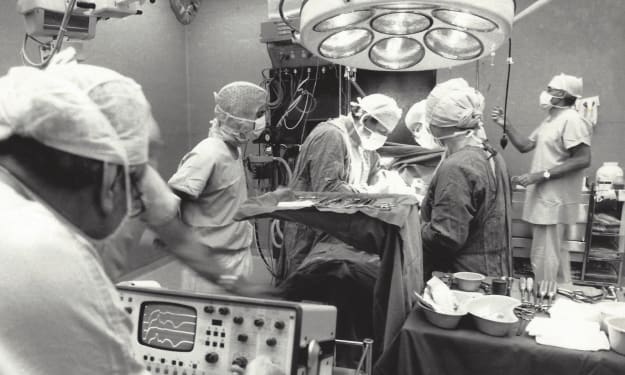Making Nanomachines That Cure from the Inside
Nanomachines curing the body from within sounds like science fiction, but for Japanese researchers, it’s a serious goal.

THE AMBITION is grand and the timeline spans decades: the development of nanomachines dispersed in the human body, performing detection, diagnosis and treatment and communicating wirelessly with physicians who monitor and direct treatment.
“In the future, you will have a whole hospital in your body,” says Prof. Kazunori Kataoka, director-general of the Innovation Centre of Nanomedicine. “The medical and diagnostic instruments, all working as nanomachines. It’s a concept we call the ‘in-body hospitals’. It isn’t a dream. We think this kind of system will be accomplished by 2045.
“In the future, you will have a whole hospital in your body. The medical and diagnostic instruments, all working as nanomachines.”
“You might have nanomachines made from organic compounds which circulate in your blood, accumulate at disease sites, such as cancer, and treat it. Or a nanomachine will capture chemical information from a disease site and bring it to an implanted chip, where analysis is carried out, and this information is transmitted to doctors outside the body.”
Is this even possible? Kataoka should know: he’s a giant in the world of biomedicine and polymer chemistry–the man who developed polymer micelle nanocarriers for targeted drug and gene delivery. The work is now close to being applied in cancer therapy and in 1996 it spawned NanoCarrier, a ¥24 billion company that is spearheading seven nanotech treatments for a host of cancers, including those of the pancreas, lung, breast, stomach, head and neck.
He sees the ‘in-body hospitals’ as a ‘moonshot’, a vision that can drive a flurry of advances in nanomedicine. It’s the primary mission of a research and development effort known as COINS, or Centre of Open Innovation Network for Smart Health.
COINS unites medical researchers, engineers and clinicians from five universities, seven government institutes, and 14 companies, among them global imaging leaders Fujifilm and Japanese chemical giants JSR and NOF. The COINS research collaboration is both led by and is housed in the Innovation Centre of NanoMedicine (or iCONM), which opened in 2015. Under the one roof, iCONM co-locates six COINS laboratories along with five other laboratories and micro-fabrication facilities adjacent to Tokyo’s Haneda International Airport.

“iCONM is designed like a big apartment complex with a concierge, aggregating multiple functions in one building,” says Kataoka. “Each floor has its own function: the first has micro-machining facilities and clean rooms, the second has facilities for material evaluation and organic synthesis, the third has laboratories for cell and genetic experiments, and the fourth has animal labs. Since these facilities follow different regulations, it is actually quite rare to have them concentrated in one building like this.”
iCONM is located in a new 40-hectare innovation hub known as the KING Skyfront (for Kawasaki INnovation Gateway at Skyfront), where more than 60 companies base their research operations alongside those from scores of universities, hospitals and government research institutes. The KING Skyfront is one of Japan’s 10 National Strategic Special Zones, where local government offers incentives to industry and the national government loosens laws and regulations to help boost innovation.
COINS is itself one of the five major industry-academia collaborations — known as the Centre of Innovation (or COI) program — funded by the Japanese Science and Technology Agency, and Ministry of Education, Culture, Sports, Science and Technology, Japan to accelerate advances in human health, or what it calls “smart life care in an ageless society”.
And human health itself is just one of the three core visions funded under the COI program — the others being quality of life and active sustainability — which are all aimed at creating a future Japan where nanotechnology, robotics, artificial intelligence and big data work seamlessly across government, industry and civil society to create both economic development and solutions to social problems.
It’s a tall order, but it’s one the Japanese government has committed to, dubbing it ‘Society 5.0’ — a convergence between the virtual and physical worlds — to solve the economic and social challenges of Japan’s rapidly ageing population and stagnant growth.
It’s a tall order: a convergence between the virtual and physical worlds to solve the economic and social challenges of Japan’s rapidly ageing population and stagnant growth.

Total Japanese government R&D investment from 2016 to 2020 — about US$228 billion — has often been structured around the ‘Society 5.0’ objective. And it’s understandable why: by 2065, 40% of Japan’s population will be older than 65. Innovation will be needed to not only extend working lives and improve well-being, but also reduce the cost of healthcare. In doing this, Japan hopes to create a plethora of new technologies and industries that will revitalise economic growth.
In this task, the ‘in-body hospitals’ moonshot will necessarily play a major part, says Kataoka: “Since it would be difficult to introduce all manner of devices into a healthy human body, we will open the way to realise this concept by first using nanotechnology to diagnose and treat diseases, or offer faster, affordable treatment that would not require hospitalisation.”
As a high school student in the 1960s, Kataoka saw the film Fantastic Voyage, in which a submarine with a crew of physicians is miniaturised to the nanoscale and injected the body of a man to remove a blood clot in his brain. “It left a strong impression,” he recalls. “Now here we are, making it a reality.”
Like this story? Please click the ♥︎ below, or send me a tip. And thanks 😊
About the Creator
Wilson da Silva
Wilson da Silva is a science journalist in Sydney | www.wilsondasilva.com | https://bit.ly/3kIF1SO






Comments
There are no comments for this story
Be the first to respond and start the conversation.